Askey Computer WLC020 PCMCIA Wireless LAN Card User Manual
Askey Computer Corp PCMCIA Wireless LAN Card
revised users manual
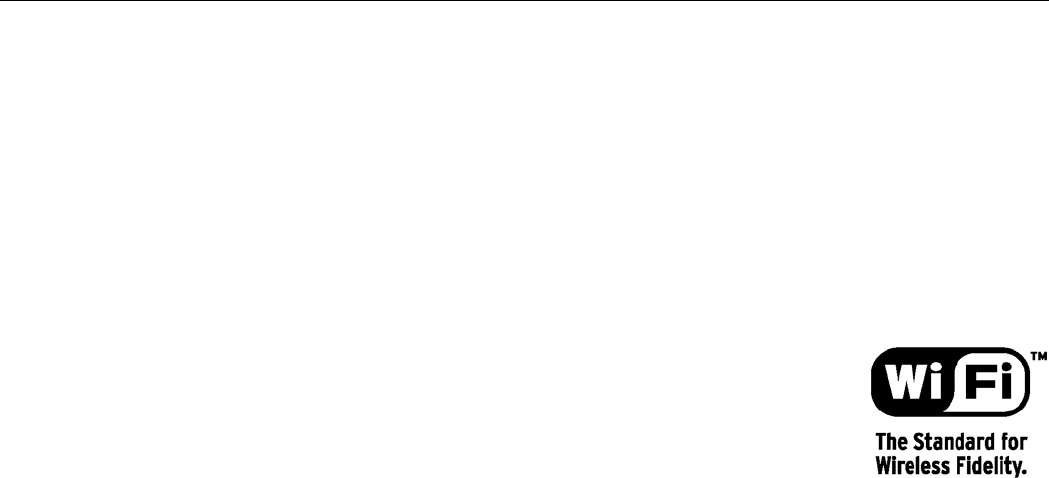
PCMCIA Wireless LAN PC Card
User’s Manual
Information in this document is subject to change without notice. No part of this document may be
reproduced or transmitted in any form or by any means, electronic or mechanical, for any purpose,
without the express written permission of the seller.
The seller provides this documentation without warranty, term, or condition of any kind. The seller
may make improvements or changes in the product(s) and/or the program(s) described in this
documentation at any time.
Other product and company names herein may be trademarks of their respective owners.
2001 All rights reserved.
I
Contents
Chapter 1 Introduction................................................................................................................. 1
Local Area Network (LAN) .......................................................................................................................................... 1
Ad Hoc Network .......................................................................................................................................................... 2
Infrastructure Network................................................................................................................................................. 2
Chapter 2 Installing the Wireless LAN Card .............................................................................. 3
System Requirements................................................................................................................................................. 3
Installing the Hardware ............................................................................................................................................... 3
Wireless LAN Card Status LEDs................................................................................................................................. 4
Installing the Device Driver ......................................................................................................................................... 5
Installing the Wireless LAN Card Software ................................................................................................................. 7
Chapter 3 Configuring the Wireless LAN Card........................................................................ 11
Connecting to Other Computers with WLAN (Ad Hoc) ............................................................................................. 12
Connecting to Access Points (Infrastructure)............................................................................................................ 14
Setting Security ......................................................................................................................................................... 16

PCMCIA Wireless LAN Card
II
Setting Power Save Mode......................................................................................................................................... 18
Checking Link Quality (Infrastructure Mode Only) .................................................................................................... 20
Chapter 4 Uninstalling the Wireless LAN Card........................................................................ 21
Removing the Wireless LAN Card ............................................................................................................................ 21
Chapter 5 Updating the Device Driver ...................................................................................... 25
Chapter 6 Troubleshooting .......................................................................................................27
Radio Interference..................................................................................................................................................... 27
Card Not Detected..................................................................................................................................................... 28
Cannot Connect to Another Wireless LAN Card....................................................................................................... 28
Poor Link Quality ....................................................................................................................................................... 29
Cannot Connect to Access Point .............................................................................................................................. 29
Appendix A Limited Warranty ................................................................................................... 31
Wireless LAN Hardware............................................................................................................................................ 31
Wireless LAN Software ............................................................................................................................................. 32
Appendix B Regulatory Compliance ........................................................................................33
FCC Part 15 Declaration of Conformity (DoC).......................................................................................................... 33
FCC Rules and Regulations - Part 15....................................................................................................................... 34
FCC Radiation Exposure Statement ......................................................................................................................... 35

Contents
III
Appendix C Setting Up TCP/IP.................................................................................................. 37
Glossary...................................................................................................................................... 39
Index............................................................................................................................................ 43
1
Chapter 1
Introduction
This User’s Manual contains information on how to install and configure your Wireless LAN
Card. Your Wireless LAN Card will allow you to connect your computer to other Wireless
LAN Card equipped computers.
Local Area Network (LAN)
Simply put, a LAN is a network that exists in a relatively limited area. A network is two or
more computers connected together sharing files and peripheral devices such as printers.
The Wireless LAN Card allows you to interact with other computers without having to run
cables normally associated with networks. This lets you move your computer around while
staying connected to your network.
There are two ways to use the Wireless LAN Card. One way is to connect directly to one or
more Wireless LAN Card equipped computers, forming an Ad Hoc wireless network. The
second way is to connect to an Access Point that gives you access to an existing wired LAN,
forming an Infrastructure wireless network.

PCMCIA Wireless LAN Card
2
Ad Hoc Network
The Ad Hoc network offers peer to peer connections
between workstations, allowing communication
between computers within range that have an 802.11
DSSS compatible PC card installed. A wireless Ad
Hoc network can also access a wired LAN’s TCP/IP
service (such as e-mail and the Internet) by using a TCP/IP software router on an Ethernet
equipped PowerBook or notebook.
Infrastructure Network
The infrastructure network uses an access
point (or several access points) as a
gateway, linking the wireless network to a
wired LAN. As a result, portable
workstations on your wireless network
have access to all of the features of your
wired LAN including e-mail, Internet
access, network printers and files server.
Server
Wired LAN
Access Point

3
Chapter 2
Installing the Wireless LAN Card
System Requirements
To use the Wireless LAN Card, your computer must meet the following minimum
requirements:
Windows 98(SE)/Me /2000
16 MB of RAM, additional memory recommended
Available (TypeII) PC card slot
Installing the Hardware
The Wireless LAN Card can be inserted into your computer’s PCMCIA slot when the
computer power is either turned on or off.
Caution: Do not force the Wireless LAN Card into the slot or severe
damage to the computer may occur.
After installing the hardware,
install the device driver and
then install the Wireless
LAN Card software.

PCMCIA Wireless LAN Card
4
Insert the end of the Wireless LAN Card into the PCMCIA slot of your computer with the
printed label facing up, and slide it in until it is firmly seated.
Wireless LAN Card Status LEDs
The two LEDs on the Wireless LAN Card indicate connection status and data transfer
operation status, as described below:
LED Color State Description
Power Red On Connected to an Ad Hoc or Infrastructure network.
Blinking Searching for an Access Point or another wireless LAN
computer.
Activity Green Blinking Transmission mode. The faster the LED blinks. The
higher the data exchange rate.
The red LED on the Wireless
LAN Card will light when
the Wireless LAN Card is
inserted into the PCMCIA
slot and the computer is
turned on.

Chapter 2 - Installing the Wireless LAN Card
5
Installing the Device Driver
Windows will automatically start the device driver installation when the Wireless LAN Card
is installed or when Windows starts.
For Windows 98(SE)
1. When the wizard appears, click Next. Then select Search for the best driver… and
click Next.
2. Insert the Installation CD into your CD-ROM drive. Check Specify a location and click
Browse to specify the path to D:\Driver\Win9x where D is the drive letter and click
Next.
3. When the driver is found, click Next to continue.
NOTE: If prompted, insert your Windows 98(SE) installation CD and then click OK.
4. Click Finish to complete the driver installation.
5. When prompted to restart your computer, click No and continue to the next task.
For Windows Me
1. When the wizard appears, select Specify the location … and click Next.
2. Insert the Installation CD into your CD-ROM drive. Select the check boxes for both
Search for the best driver … and Specify a location. Click Browse to specify the path
to D:\Driver\WinME where D is the drive letter and click Next.
3. When the driver is found, click Next to continue.
4. Click Finish to complete the driver installation.
If you need to set up the TCP/IP
address or the Subnet Mask,
refer to “Appendix C - Setting
Up TCP/IP” on page 35.
Have your Windows 98(SE)
/Me installation CD-ROM or
disks available; Windows may
prompt you for them.

PCMCIA Wireless LAN Card
6
For Windows 2000
1. When the wizard appears, click Next.
2. Select Search for a suitable driver… and click Next.
3. Check Specify a location and click Next.
4. Insert the Installation CD into your CD-ROM drive. Click Browse to specify the path to
D: \Driver\W2K where D is the drive letter and click OK.
5. When the driver is found, click Next to continue.
6. When the Digital Signature Not Found message appears, click Yes.
7. Click Finish to complete the driver installation.

Chapter 2 - Installing the Wireless LAN Card
7
Installing the Wireless LAN Card Software
1. Close all Windows programs that are running.
2. Run Setup.exe from the D:\Utility folder of the Wireless LAN Card Installation CD-
ROM where D is the drive letter, and then click Next.
3. Click Yes to accept the Software Licensing Agreement.
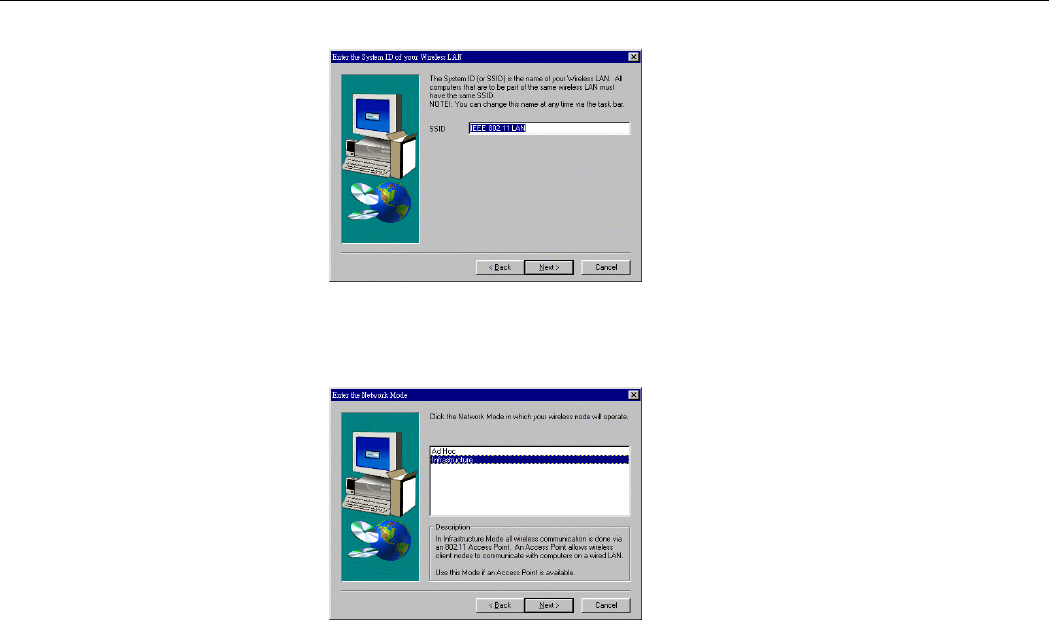
PCMCIA Wireless LAN Card
8
4. In the SSID box, enter the Service Set ID name, and then click Next.
5. Write down the Service Set ID name exactly as you have entered it (for use in a later
installation step), and then click OK.
6. Click the network mode (AdHoc or Infrastructure) in which your wireless client will
operate, and then click Next.
If you will be communicating in
a wireless network only, choose
AdHoc.
If you will be communicating
through an Access Point that is
connected to a wired LAN
installation, choose
Infrastructure.
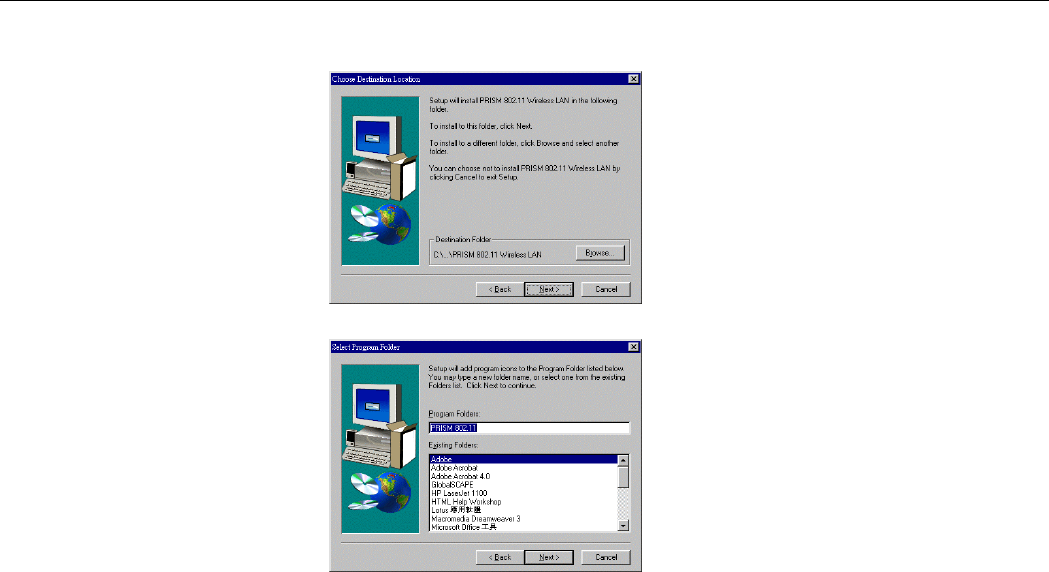
Chapter 2 - Installing the Wireless LAN Card
9
7. To install the software to the default destination folder, click Next. To install to a
different folder, click Browse, select another folder, and then click Next.
8. Click Next to continue.

PCMCIA Wireless LAN Card
10
9. After Windows copies the Setup files from the Wireless LAN Card CD-ROM, click Yes,
I want to restart my computer now, and then click Finish.
11
Chapter 3
Configuring the Wireless LAN Card
You can connect your computer to a network in one of two ways:
Ad Hoc Connecting to other Wireless LAN Card equipped computers, forming a
wireless network.
Infrastructure Connecting to a wired network through an Access Point.
When the Wireless LAN Card is installed and your computer is turned on, one of the
following Wireless LAN Link Status icons will be displayed in the taskbar at the bottom
right corner of your Windows screen:
Not Linked Computer is not connected to any other computers. (Red)
Linked Computer joined to a network or formed a network. (Green)

PCMCIA Wireless LAN Card
12
Connecting to Other Computers with WLAN (Ad Hoc)
To connect your computer to an Ad Hoc network, complete the following steps:
1. In the taskbar, click the Wireless LAN Link Status icon to display the Wireless LAN
Configuration Utility dialog box.
2. Click the Configuration tab.
3. In the Mode list, click AdHoc.
4. In the SSID list, click the Service Set ID (SSID) name of the Wireless LAN group. All
wireless clients must use the same SSID in order to communicate with each other.
5. In the Channel list, click up or down to get the correct Channel Number which is the
same as used by other computer to be connected to.
6. Click Apply Changes. You should now be able to find your computer on the Network
Neighborhood in Windows Explorer.
7. Click OK to exit the utility.
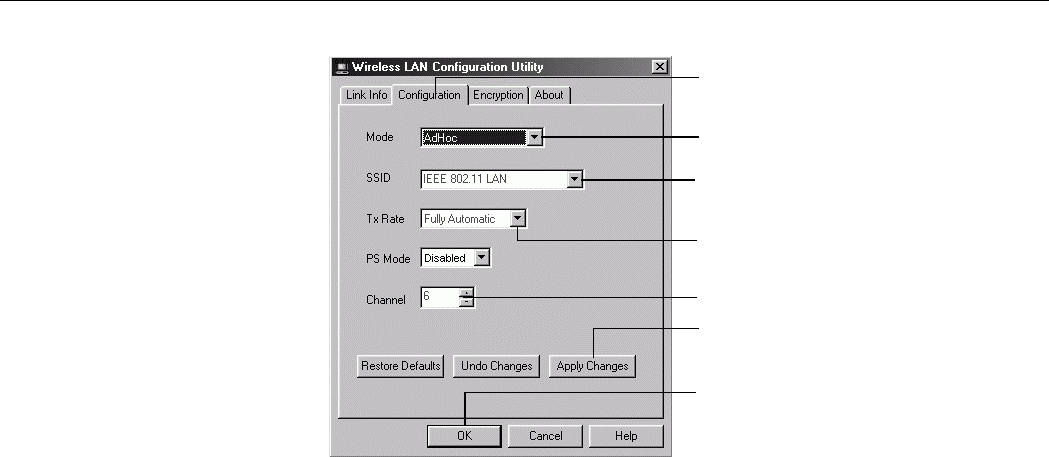
Chapter 3 – Configuring the Wireless LAN Card
13
1. Click the Confi
g
uration tab.
2. Click AdHoc.
3. Click SSID name of the Wireless LAN
group.
Default: Fully Automatic.
4. Click Channel Number.
5. Click Apply Changes.
6. Click OK.

PCMCIA Wireless LAN Card
14
Connecting to Access Points (Infrastructure)
To connect your computer to an Infrastructure network, complete the following steps:
1. In the taskbar, click the Wireless LAN Link Status icon to display the Wireless LAN
Configuration Utility dialog box.
2. Click the Configuration tab.
3. In the Mode list, click Infrastructure.
4. In the SSID list, click SSID name of the Access Point. All wireless clients must use the
same SSID in order to communicate with each other.
5. Click Apply Changes. You should now be able to find your computer on the Network
Neighborhood in Windows Explorer.
6. Click OK to exit the utility.
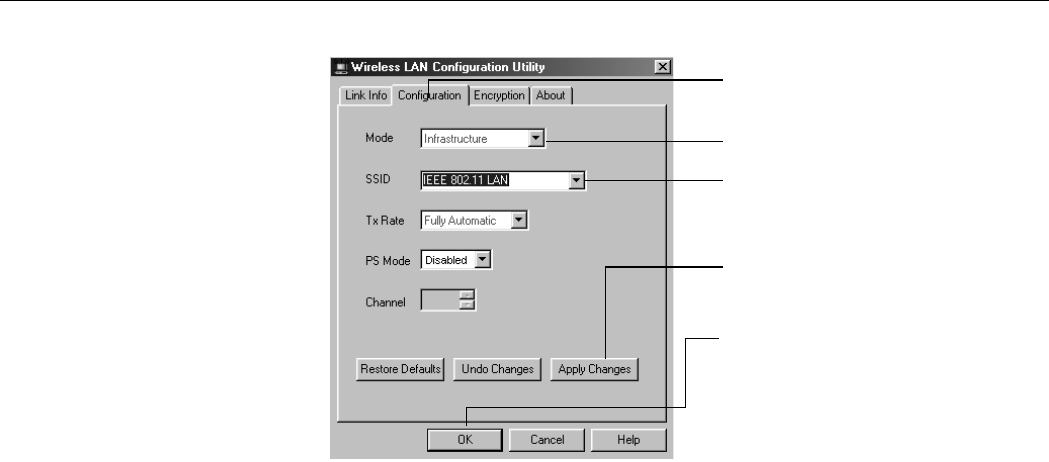
Chapter 3 – Configuring the Wireless LAN Card
15
1. Click the Configuration tab.
2. Click Infrastructure.
3. Click SSID name of the Access
Point.
4. Click Apply Changes.
5. Click OK to exit the utility.

PCMCIA Wireless LAN Card
16
Setting Security
Your encryption settings must match those of your network, or your computer will be unable
to communicate.
To establish a secure wireless network, complete the following steps:
1. In the taskbar, click the Wireless LAN Link Status icon to display the Wireless LAN
Configuration Utility dialog box.
2. Click the Encryption tab.
3. In the WEP (Wired Equivalent Privacy) list, click the proper WEP setting.
4. In the Passphrase box, enter the password or phrase, or click the Manual Entry.
5. Click Apply, and then click OK.
The Passphrase of each
computer must be the same
before a connection can be
made between the computers.
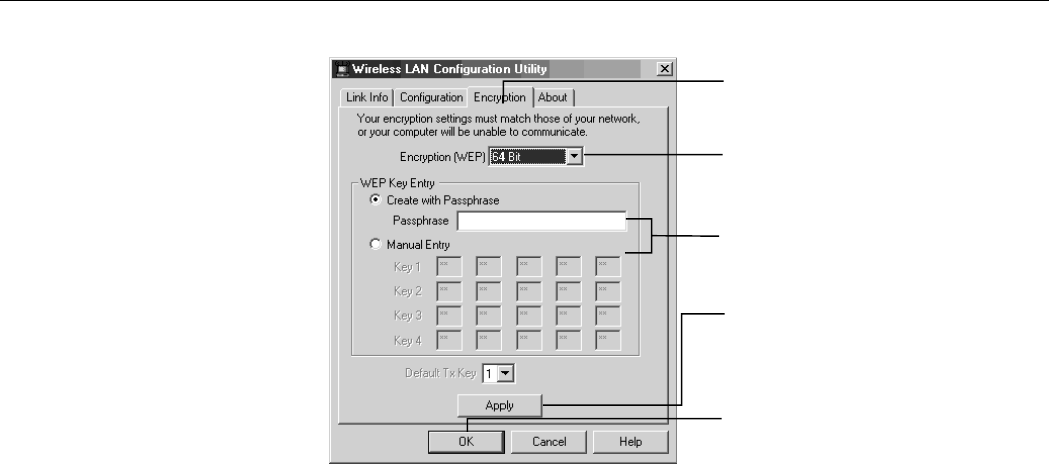
Chapter 3 – Configuring the Wireless LAN Card
17
1. Click the Encryption tab.
2. Click the proper WEP setting.
3. Enter the password or phrase, or click
the Manual Entry.
4. Click Apply.
5. Click OK to exit the utility.

PCMCIA Wireless LAN Card
18
Setting Power Save Mode
Power Save Mode is recommended for devices where power consumption is a major concern,
such as battery-powered devices. While in Power Save Mode the Access Point stores
incoming messages in a memory buffer. The Wireless LAN Card wakes up periodically from
Power Save Mode and checks for any messages that might be waiting at the Access Point.
After the messages are transmitted to the Wireless LAN Card from the Access Point, the
Wireless LAN Card goes back into Power Save Mode.
1. In the taskbar, click the Wireless LAN Link Status icon to display the Wireless LAN
Configuration Utility dialog box.
2. Click the Configuration tab.
3. In the PS Mode (Power Save Mode) list, click Enabled, and then click Apply Changes.
4. Click OK to exit the utility.
You may need to minimize
all other Windows programs
that are currently running.
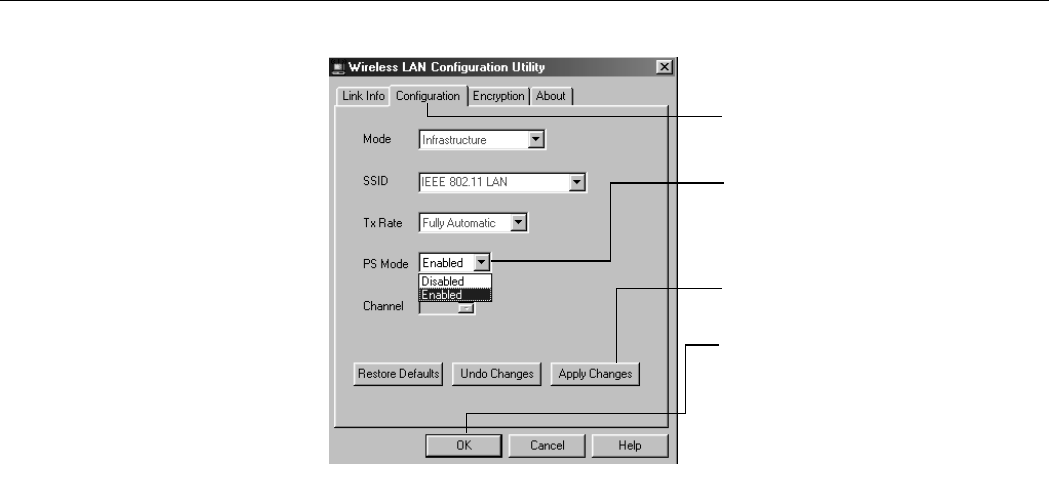
Chapter 3 – Configuring the Wireless LAN Card
19
1. Click the Configuration tab.
2. In the PS Mode (Power Save) list, click
Enabled.
3. Click Apply Changes.
4. Click OK to exit the utility.
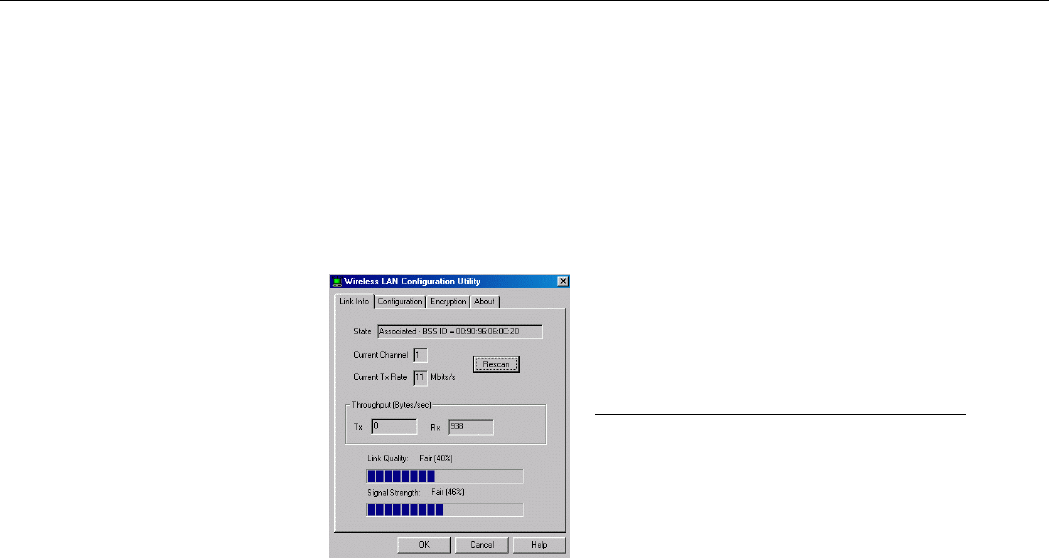
PCMCIA Wireless LAN Card
20
Checking Link Quality (Infrastructure Mode Only)
To check the quality of your computer’s wireless link to an Access Point, complete the
following steps:
1. Click the Link Info tab.
The State box shows the MAC address for the Access Point.
2. Link Quality and Signal Strength are displayed as percentages using active progress
indicators that change as the network radio signal fluctuates. Link Quality categories are
defined as follows:
3. Click OK to exit the utility.
Link Quality Range (%)
Poor 0-29
Fair 30-59
Good 60-89
Excellent 90-100
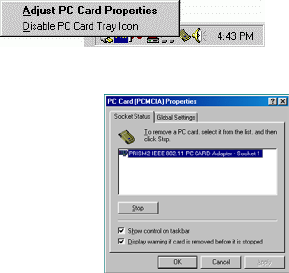
21
Chapter 4
Uninstalling the Wireless LAN Card
Removing the Wireless LAN Card
The Wireless LAN Card complies with the PCMCIA standard that allows devices to be
inserted into and removed from the computer’s
PCMCIA socket when the computer is on. It is
recommended that you follow the standard Windows
procedure for disconnecting a PCMCIA device from your computer.
1. In the taskbar, click the PCMCIA icon, and then click Adjust
PC Card Properties.
2. Select the Wireless LAN Card which you want to remove, click
Stop and then click OK.
3. When the message appears that tells you it is safe to remove
device, click OK and remove the Wireless LAN Card from the
computer.
You should use the PC Card
icon on the taskbar to stop
PC Card before removing
them. Removing card
without warning the system
can cause unexpected
problems.
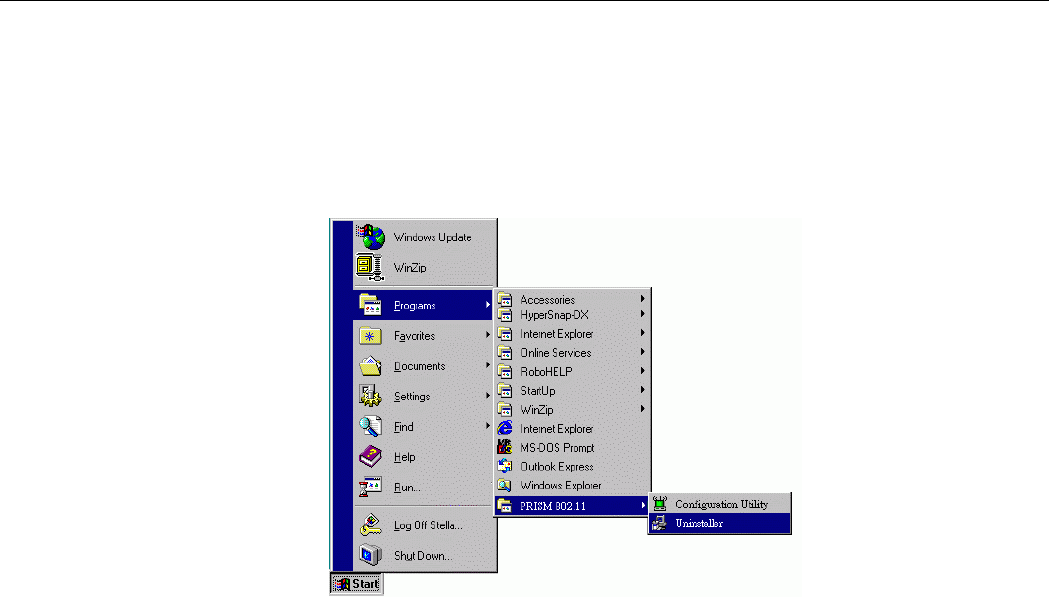
PCMCIA Wireless LAN Card
22
Uninstalling the Wireless LAN Card Software
If you need to uninstall the Wireless LAN Card and application software for any reason,
complete the following steps:
1. Close all programs that are currently running.
2. Remove the Wireless LAN Card from the computer.
3. Click the Windows Start button, point to Programs, PRISM 802.11 and then click
Uninstaller.
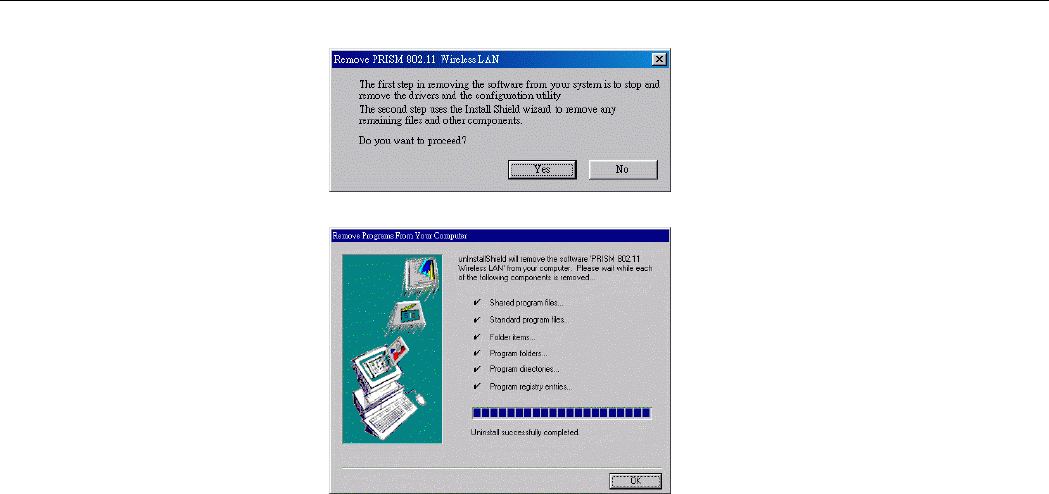
Chapter 4 – Uninstalling the Wireless LAN Card
23
4. Click Yes to proceed with the software procedure.
5. When the uninstallation is completed, click OK.
25
Chapter 5
Updating the Device Driver
To update the device driver, you have to remove the old driver first and then install a new one.
For the latest driver, please visit our web site for more information. When you have finished
the download procedure, please follow as below to update the device driver.
1. Uninstall the Wireless LAN Card as described in Chapter 4. Follow the steps to remove
the Wireless LAN Card and then uninstall the software.
2. Install the new driver you have downloaded. Refer to Chapter 2 for detailed instructions.
Once you finish installing the new driver, the updating is complete.
27
Chapter 6
Troubleshooting
Radio Interference
You may be able to eliminate any interference by trying the following:
• Reseat the Wireless LAN Card.
• Increase the distance between the wireless computers and the device causing the radio
interference.
• Plug the computer equipped with the Wireless LAN Card into an outlet on a different
branch circuit from that used by the affecting device.
• Consult the dealer or an experienced radio technician for help.
• Keep the computer with the Wireless LAN Card away from the microwave oven and
large metal objects.

PCMCIA Wireless LAN Card
28
Card Not Detected
If the Wireless LAN Card is not detected by Windows, try the following:
• Make sure the Wireless LAN Card is properly inserted in the PCMCIA slot.
• Make sure the PCMCIA slot in your computer is working.
• Contact your dealer for additional testing if there is a hardware problem with the
Wireless LAN Card.
Cannot Connect to Another Wireless LAN Card
If you cannot make a connection to another Wireless LAN Card from your computer, it could
be due to one of the following reasons:
• Incorrect SSID. Make sure the SSID is the same for all computers that have a Wireless
LAN Card.
• Changes are not being recognized by your computer. Restart your computer.
• If in Ad Hoc mode, make sure the Log on to Windows NT domain check box is not
selected in the Client for Microsoft Networks Properties dialog box in the Network
Configuration tab.
• Incorrect IP Address or Subnet Mask. Check these settings in the TCP/IP Properties
dialog box in the Network Configuration tab.
• Make sure the channel for the Wireless LAN Card is set to the same channel number as
the one for the other Wireless LAN card you are trying to connected to.

Chapter 6 – Troubleshooting
29
Poor Link Quality
If the Link Quality display stays in the Poor range, it could be due to one of the following
reasons:
• Radio interference.
• Distance between Wireless LAN Card and Access Point is too far. Decrease the
distance between the Wireless LAN Card and Access Point (or another card).
Cannot Connect to Access Point
If you cannot make a connection to the Access Point, it could be due to one of the following
reasons:
• Make sure the Wireless LAN Card and Access Point have no physical connection
problems.
• Make sure the SSID for the Wireless LAN Card is set to “null” or is the same as the
Access Point.
• Make sure the privacy type is the same as that of Access Point. If both are using a
Passphrase, make sure it is the same for both computers. Also, make sure the Default
Key is the same for both computers.
31
Appendix A
Limited Warranty
Wireless LAN Hardware
The seller warrants to the end user (“Customer”) that this hardware product will be free from
defects in workmanship and materials, under normal use and service, for 1 year from the date
of purchase from the seller or its authorized reseller. The seller’s sole obligation under this
express warranty shall be, at the seller’s option and expense, to repair the defective product or
part, deliver to Customer an equivalent product or part to replace the defective item, or if
neither of the two foregoing options is reasonably available, The seller may, in its sole
discretion, refund to the Customer the purchase price paid for the defective product. All
products that are replaced will become the property of the seller. Replacement products may
be new or reconditioned.

PCMCIA Wireless LAN Card
32
Wireless LAN Software
The seller warrants to Customer that each software program licensed from it , except as noted
below, will perform in substantial conformance to its program specifications, for a period of 1
year from the date of purchase from the seller or its authorized reseller. The seller warrants the
media containing software against failure during the warranty period. No updates are provided.
The seller’s sole obligation under this express warranty shall be, at the seller’s option and
expense, to refund the purchase price paid by Customer for any defective software product, or
to replace any defective media with software which substantially conforms to applicable seller
published specifications. Customer assumes responsibility for the selection of the appropriate
application programs and associated reference materials. The seller makes no warranty or
representation that its software products will meet Customer’s requirements or work in
combination with any hardware or software applications products provided by third parties,
that the operation of the software products will be uninterrupted or error free, or that all
defects in the software products will be corrected. For any third party products listed in the
seller software product documentation or specifications as being compatible, the seller will
make reasonable efforts to provide compatibility, except where the non-compatibility is
caused by a defect in the third party’s product or from use of the software product not in
accordance with the seller’s published specifications or user manual.
33
Appendix B
Regulatory Compliance
FCC Part 15 Declaration of Conformity (DoC)
The following equipment:
Product Name: Wireless PC LAN Card
is herewith confirmed to comply with the requirements of FCC Part 15 rules. The operation is
subject to the following two conditions:
1. This device may not cause harmful interference, and
2. This device must accept any interference received, including interference that may cause
undesired operation.

PCMCIA Wireless LAN Card
34
FCC Rules and Regulations - Part 15
Warning:
● This equipment must be install and operated in accordance with provided instructions and
minimum 20 cm spacing must be provided between computer mounted antenna and person’s
body (excluding extremities of hands , wrist and feet ) during wireless modes of operation .
● This device complies with Part 15 of the FCC Rules . Operation is subject to the following two
conditions : (1) this device may not cause harmful interference , and (2) this device must
accept any interference received , including interference that may cause undesired operation .
Caution
Any changes or modifications not expressly approved by the party responsible for compliance
could void the authority to operate equipment .
This device has been tested and found to comply with the limits for a Class B digital device pursuant to
Part 15 of the Federal Communications Commissions Rules and Regulation. These limits are designed to
provide reasonable protection against harmful interference when the equipment is operated in a
commercial environment. This equipment generates, uses, and can radiate radio frequency energy and, if
not installed and used in accordance with the instruction manual, may cause harmful interference to radio
communications.
However, there is no guarantee that interference will not occur in a particular installation. If this
equipment does cause harmful interference to radio or television reception, which can be determined by

Chapter 6 – Troubleshooting
35
turning the equipment off and on, the user is encouraged to try and correct the interference by one or
more of the following measures:
• Relocate your WLAN equipped laptop computer.
• Increase the separation between the WLAN equipped laptop computer and other electronics.
• Connect the WLAN equipped laptop computer into an outlet on a circuit different from that of
other electronics.
• Consult the dealer or an experienced radio/TV technician for help.
FCC Radiation Exposure Statement
This equipment complies with FCC radiation exposure limits set forth for an uncontrolled
environment. This device and its antenna(s) must not be co-located or operating in
conjunction with any other antenna or transmitter.
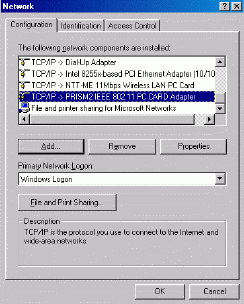
37
Appendix C
Setting Up TCP/IP
1. On the taskbar, click the Start -> Settings -> Control Panel, double click the Network
icon.
2. Click the Configuration tab of the Network dialog box.
3. In the network components list, click TCP/IP ->PRISM2 IEEE 802.11 PC CARD
Adapter, and then click Properties.

PCMCIA Wireless LAN Card
38
4. On the IP Address tab, click Specify an IP address. In the IP Address box, enter a
valid four-component IP address, either a public or private one as required. If private IP
address is used, the following three blocks of IP addresses are available for private
networks:
10. 0 . 0. 0 — 10.255.255.255
172. 16. 0. 0 — 172. 31.255.255
192.168. 0. 0 — 192.168.255.255
5. In the Subnet Mask box, enter a valid four-component IP address.
6. Click OK, and then click Yes to restart your computer.
The subnet mask is a value
that defines whether your
computer communicates
only within your LAN (for
example, 255.255.255.0) or
communicates outside of
your LAN.
For correct IP address
information for your
wireless LAN installation,
contact your network
administrator.
For more information on IP
addresses, see the Network
Working Group
Specification RFC 1918 on
the Internet.
39
Glossary
10BaseT An IEEE standard (802.3) for operating 10 Mbps Ethernet networks (LANs) with twisted pair
cabling and a wiring hub.
Access Point An internetworking device that seamlessly connects wired and wireless networks. Access Points
combined with a distributed system support the creation of multiple radio cells that enable
roaming throughout a facility.
Ad Hoc A network composed solely of stations within mutual communication range of each other (no
Access Point connected).
BSS Basic Service Set. A set of stations controlled by a single coordination function.
Channel A medium used to pass protocol data units that can be used simultaneously in the same volume
of space by other channels of the same physical layer, with an acceptably low frame error ratio
due to mutual interference.
Encapsulated An Ethernet address mode that treats the entire Ethernet packet as a whole and places it inside
an 802.11 frame along with a new header.
ESS Extended Service Set. A set of one or more interconnected Basic Service Sets (BSSs) and
integrated Local Area Networks (LANs) can be configured as an Extended Service Set.

PCMCIA Wireless LAN Card
40
Ethernet The most widely used medium access method, which is defined by the IEEE 802.3 standard.
Ethernet is normally a shared media LAN; i.e., all the devices on the network segment share
total bandwidth. Ethernet networks operate at 10Mbps using CSMA/CD to run over 10BaseT
cables.
Gateway A network component that acts as an entrance to another network.
IEEE 802.11 The IEEE 802.xx is a set of specifications for LANs from the Institute of Electrical and
Electronic Engineers (IEEE). Most wired networks conform to 802.3, the specification for
CSMA/CD-based Ethernet networks or 802.5, the specification for token ring networks. 802.11
defines the standard for wireless LANs encompassing three incompatible (non-interoperable)
technologies: Frequency Hopping Spread Spectrum (FHSS), Direct Sequence Spread Spectrum
(DSSS), and Infrared. IEEE standards ensure interoperability between systems of the same type.
Infrastructure A wireless network centered about an Access Point. In this environment, the Access Point not
only provides communication with the wired network but also mediates wireless network traffic
in the immediate neighborhood.
IP Internet Protocol. The standard protocol within TCP/IP that defines the basic unit of
information passed across an Internet connection by breaking down data messages into packets,
routing and transporting the packets over network connections, then reassembling the packets at
their destination. IP corresponds to the network layer in the ISO/OSI model.
IP Address An IP address is a 32-bit number that identifies each sender or receiver of information sent
across the Internet. An IP address has two parts: the identifier of a particular network on the
Internet and an identifier of the particular device (which can be a server or a workstation) within
that network.

Glossary
41
ISP Internet Service Provider. An organization that provides access to the Internet. Small ISPs
provide service via modem and ISDN while the larger ones also offer private line hookups (T1,
fractional T1, etc.).
LAN Local Area Network. A communications network that serves users within a defined
geographical area. The benefits include the sharing of Internet access, files, and equipment, such
as printers and storage devices. Special network cabling (10BaseT) is often used to connect the
PCs together.
NAT Network Address Translation. The translation of an Internet Protocol address (IP address) used
within one network to a different IP address known within another network. One network is
designated the internal network and the other is the external. The internal network then appears
as one entity to the outside world.
PCMCIA Personal Computer Memory Card International Association. This Association develops
standards for PC cards, formerly known as PCMCIA cards. These cards are available in three
types, and are about the same length and width as credit cards. However, the different cards
range in thickness from 3.3 mm (Type I) to 5.0 mm (Type II) to 10.5 mm (Type III). These
cards can be used for various functions, including memory storage, landline modems, and
wireless modems.
PS Mode Power Save Mode. This mode is recommended for devices where power consumption is a major
concern, such as battery-powered devices.

PCMCIA Wireless LAN Card
42
Radio
Frequency
RF, Terms: GHz, MHz, Hz —The international unit for measuring frequency is Hertz (Hz),
equivalent to the older unit of cycles per second. One megahertz (MHz) is one Million-Hertz.
One giga hertz (GHz) is one Billion-Hertz. The standard U.S. electrical power frequency is 60
Hz, the AM broadcast radio frequency band is 0.55–1.6 MHz, the FM broadcast radio frequency
band is 88–108 MHz, and wireless 802.11 LANs operate at 2.4GHz.
SSID Service Set ID. A group name shared by every member of a wireless network. Only client PCs
with the same SSID are allowed to establish a connection.
Subnet Mask A value that defines whether your computer communicates only within your LAN or
communicates outside of your LAN, where it is routed out to the rest of the Internet. A Subnet
Mask that has the same first three components (for example, 255.255.255.0) is the routing
pattern for a Class C address.
TCP Transmission Control Protocol. The standard transport level protocol that provides the full
duplex, stream service on which many applications’ protocols depend. TCP allows a process on
one machine to send a stream of data to a process on another. Software implementing TCP
usually resides in the operating system and uses the IP to transmit information across the
network.
WEP Wired Equivalent Privacy. The optional cryptographic confidentiality algorithm specified by
802.11. The algorithm is being used to provide data confidentiality that is subjectively
equivalent to the confidentiality of a wired LAN medium that does not employ cryptographic
techniques to enhance privacy..
43
Index
1
10BaseT, 37
A
Access Point, 1, 2, 4, 11, 14, 18, 20, 29, 37, 38
Ad Hoc, 1, 2, 4, 11, 12, 28, 37
AdHoc, 8, 12
B
battery-powered devices, 18
BSS, 37
C
Cannot connect to Access Point
troubleshooting, 29
Cannot connect to another Wireless LAN Card
troubleshooting, 28
Card not detected
Troubleshooting, 28
Channel, 12, 28, 37
Checking
link quality, 20
Computer power, 3
Connecting to other Wireless LAN Card, 11
D
Default destination folder, 9
Device driver
updating, 25
Driver
installing, 5
E
ESS, 37
Ethernet, 2, 37, 38
G
Gateway, 2, 38
Glossary, 37

PCMCIA Wireless LAN Card
44
H
Hardware, 31, 32
installing, 3
problem, 28
I
Icons
status, 11
IEEE, 35, 37, 38
Infrastructure, 1, 2, 4, 8, 11, 14, 20, 38
Installing
hardware, 3
Wireless LAN Card, 3
IP Address, 28, 36, 38
ISP, 39
L
LAN, i, 2, 3, 4, 7, 10, 11, 12, 14, 16, 18, 21, 22, 25, 27, 28,
29, 31, 32, 33, 34, 37, 38, 39, 40
LED, 4
Link Quality
checking, 20
N
NAT, 39
Network, 1, 2, 4, 8, 11, 12, 14, 16, 20, 35, 36, 37, 38, 39, 40
P
PCMCIA, 3, 4, 21, 28, 39
card slot, 3
Poor Link Quality
Troubleshooting, 29
Power Save Mode, 18, 39
setting, 18
Progress indicators, 20
PS, 39
R
Radio Frequency, 34, 40
Radio Interference, 27
RAM, 3
Removing
Wireless LAN Card, 21
Restart
computer, 28
S
Security
setting, 16
Service Set ID, 8, 12, 40
Setting

Index
45
Power Save Mode, 18
security, 16
Setting Up
TCP/IP, 35
Setup.exe, 7
Software
installing, 7
uninstalling, 22
Software Licensing Agreement, 7
SSID, 8, 12, 14, 28, 29, 40
Status icons, 11
Subnet Mask, 28, 36, 40
T
Taskbar, 11, 12, 14, 16, 18, 21, 35
TCP/IP, 2, 28, 35, 38
Troubleshooting
cannot connect to Access Point, 29
cannot connect to another Wireless LAN Card, 28
card not detected, 28
poor link quality, 29
radio interference, 27
U
Uninstalling
Wireless LAN Card, 21
Updating
device driver, 25
Utility
installing, 7
W
WEP, 40
Wired Equivalent Privacy, 16, 40
Wireless LAN Card
inserting into PCMCIA slot, 3